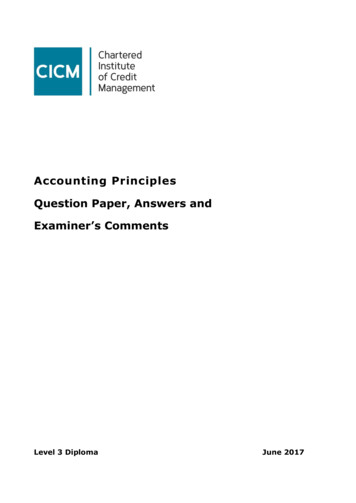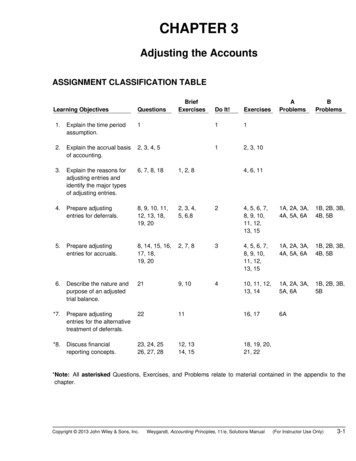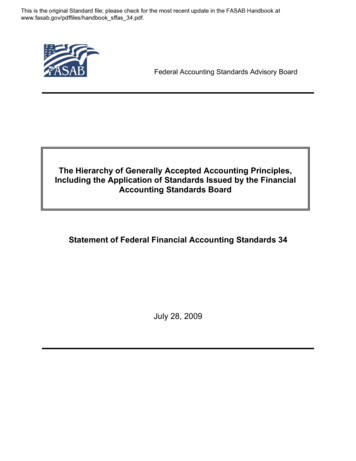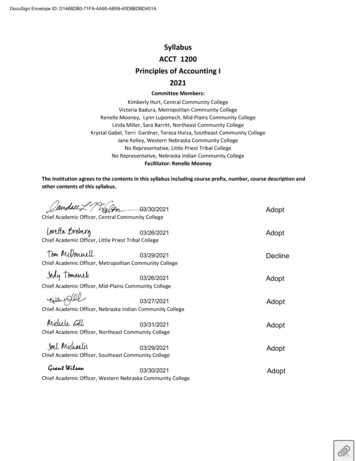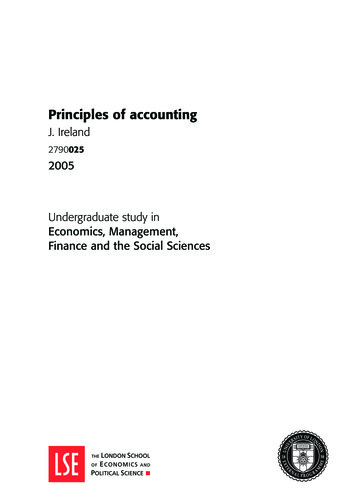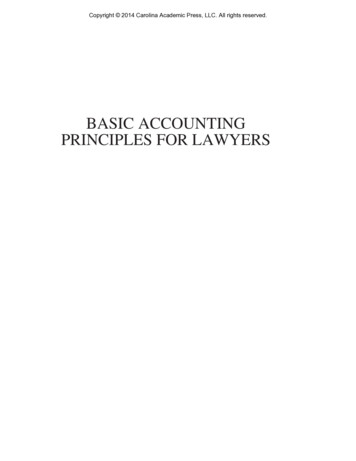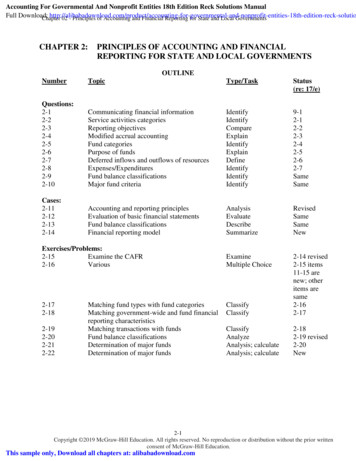
Transcription
Accounting For Governmental And Nonprofit Entities 18th Edition Reck Solutions ManualFull edition-reck-solutioChapter02 - Principles of Accounting and Financial Reporting for State and Local GovernmentsCHAPTER 2:PRINCIPLES OF ACCOUNTING AND FINANCIALREPORTING FOR STATE AND LOCAL GOVERNMENTSOUTLINENumberTopicType/TaskStatus(re: unicating financial informationService activities categoriesReporting objectivesModified accrual accountingFund categoriesPurpose of fundsDeferred inflows and outflows of resourcesExpenses/ExpendituresFund balance classificationsMajor fund 52-62-7SameSameCases:2-112-122-132-14Accounting and reporting principlesEvaluation of basic financial statementsFund balance classificationsFinancial reporting ameNewExercises/Problems:2-15Examine the CAFR2-16VariousExamineMultiple Choice2-172-18ClassifyClassify2-14 revised2-15 items11-15 arenew; otheritems aresame2-162-17ClassifyAnalyzeAnalysis; calculateAnalysis; calculate2-182-19 revised2-20New2-192-202-212-22Matching fund types with fund categoriesMatching government-wide and fund financialreporting characteristicsMatching transactions with fundsFund balance classificationsDetermination of major fundsDetermination of major funds2-1Copyright 2019 McGraw-Hill Education. All rights reserved. No reproduction or distribution without the prior writtenconsent of McGraw-Hill Education.This sample only, Download all chapters at: alibabadownload.com
Chapter 02 - Principles of Accounting and Financial Reporting for State and Local GovernmentsCHAPTER 2:PRINCIPLES OF ACCOUNTING AND FINANCIALREPORTING FOR STATE AND LOCAL GOVERNMENTSAnswers to Questions2-1.GASB Concepts Statement No. 3 indicates that it is preferable to recognize an item on theface of the financial statements if the item meets the definition of an element and can bemeasured with sufficient reliability to allow it to be recorded. Note disclosures shouldaccompany items recognized on the financial statements if the note can provide the userwith essential information about the item. For example, notes accompany investments toallow the reader to understand the risk associated with the investment. Notes related tolong-term liabilities provide important information about payment schedules, types ofdebt, and interest related to the debt. This type of information cannot be determined bylooking at a number reported on the financial statements.General Problem Information: Communicating financial informationLearning Objective: 2-1Topic: Conceptual Framework—Providing Useful Financial ReportsBloom’s Taxonomy: RememberAccreditation Skills tag: AACSB: Knowledge Application, AICPA: FN: ReportingLevel of Difficulty: Easy2-2.The three categories of broad service activities of a general purpose government aregovernmental, business-type, and fiduciary. Governmental activities includeadministrative support and core government services. Business-type activities areactivities that are generally intended to be self-supporting, such as public utilities.Fiduciary activities are those where the government acts as a trustee or custodian forparties outside the government.General Problem Information: Service activities categoriesLearning Objective: 2-2Topic: Activities of GovernmentBloom’s Taxonomy: RememberAccreditation Skills tag: AACSB: Communication, AICPA: BB IndustryLevel of Difficulty: Easy2-3.The primary objective of government-wide financial reporting is to report on thegovernment’s operational accountability so that users can evaluate whether thegovernment is covering the cost of its services over the long run. Additionally, recallfrom Chapter 1 that operational accountability relates to how efficiently and effectivelythe government is using its resources in meeting its objectives. The objective ofgovernmental fund financial reporting is to report on the government’s fiscalaccountability. Thus, governmental fund financial reporting helps users evaluate the shortrun objective of whether financial resources were raised and spent in accordance with2-2Copyright 2019 McGraw-Hill Education. All rights reserved. No reproduction or distribution without the prior writtenconsent of McGraw-Hill Education.
Chapter 02 - Principles of Accounting and Financial Reporting for State and Local GovernmentsCh. 2, Answers, Question 2-3 (Cont’d)legal and budgetary restrictions. As can be seen from the objectives, the focus of thegovernment-wide statements tends to be more long run and related to cost of services;whereas, the governmental fund financial statements tends to be short run and related towhether costs for services were incurred in accordance with restrictions.General Problem Information: Reporting objectivesLearning Objective: 2-3Topic: Financial Reporting ModelBloom’s Taxonomy: UnderstandAccreditation Skills tag: AACSB: Communication, AICPA: BB IndustryLevel of Difficulty: Medium2-4.The modified accrual basis of accounting records revenues when they are measurable andavailable for use in paying current period obligations, while expenditures are recordedwhen an obligation has been incurred that will be paid from current financial resources.Because governmental fund financial statements focus on fiscal accountability, this basisof accounting allows for a focus on current sources and uses of financial resources asopposed to the longer-term view provided by accrual accounting.General Problem Information: Modified accrual accountingLearning Objective: 2-3Topic: Financial Reporting ModelBloom’s Taxonomy: UnderstandAccreditation Skills tag: AACSB: Communication, AICPA: FN ReportingLevel of Difficulty: Medium2-5.The three categories of funds are governmental, proprietary, and fiduciary. The fundtypes included in each category are shown below:GovernmentalGeneral FundSpecial revenue fundsDebt service fundsCapital projects fundsPermanent fundsProprietaryEnterprise fundsInternal service fundsFiduciaryCustodial fundsInvestment trust fundsPension (and other employeebenefit) trust fundsPrivate-purpose trust fundsThe basis of accounting used by governmental funds is modified accrual. Proprietaryfunds use the accrual basis of accounting, as do fiduciary funds.General Problem Information: Fund categoriesLearning Objective: 2-3Topic: Financial Reporting ModelBloom’s Taxonomy: RememberAccreditation Skills tag: AACSB: Communication, AICPA: FN ReportingLevel of Difficulty: Easy2-3Copyright 2019 McGraw-Hill Education. All rights reserved. No reproduction or distribution without the prior writtenconsent of McGraw-Hill Education.
Chapter 02 - Principles of Accounting and Financial Reporting for State and Local GovernmentsCh. 2, Answers (Cont’d)2-6.Governmental accounting systems must provide both reporting in accordance with GAAPand reporting to determine and demonstrate compliance with finance-related legal andcontractual requirements. To ensure that both GAAP and compliance reportingrequirements are met, a separate accounting mechanism is used. The mechanism that isused is fund accounting, which makes it possible to ensure that the compliance reportingrequirement is met.A fund is a separate reporting entity that may be established by imposition of grant orcontract provisions by external parties, by constitutional provisions or legislation, or bydiscretionary action of the reporting government.General Problem Information: Purpose of fundsLearning Objective: 2-3Topic: Financial Reporting ModelBloom’s Taxonomy: UnderstandAccreditation Skills tag: AACSB: Communication, AICPA: FN ReportingLevel of Difficulty: Medium2-7.Deferred outflows of resources are resources that have been consumed but are applicableto a future reporting period (e.g., costs related to a debt refunding). Deferred outflowsincrease net position. Deferred inflows of resources are resources that have been acquiredbut are applicable to a future period (e.g. resources received but unavailable for use untila future period). Deferred inflows decrease net position. These accounts, used only whenrequired by a GASB standard, represent timing differences between the actual outflow orinflow of cash and the time period to which they apply.General Problem Information: Deferred inflows and outflows of resourcesLearning Objective: 2-3Topic: Financial Reporting ModelBloom’s Taxonomy: RememberAccreditation Skills tag: AACSB: Communication, AICPA: FN ReportingLevel of Difficulty: Easy2-8Expenditures report actual outlays of funds, whether for an operating cost or the purchaseof an asset. Expenses focus on costs necessary to generate revenues or fund operations,and may be a result of the using up or expiration of an asset, even if no cash was paid out.General Problem Information: Expenses/ExpendituresLearning Objective: 2-3Topic: Financial Reporting ModelBloom’s Taxonomy: RememberAccreditation Skills tag: AACSB: Communication, AICPA: FN ReportingLevel of Difficulty: Easy2-4Copyright 2019 McGraw-Hill Education. All rights reserved. No reproduction or distribution without the prior writtenconsent of McGraw-Hill Education.
Chapter 02 - Principles of Accounting and Financial Reporting for State and Local GovernmentsCh. 2, Answers (Cont’d)2-9.The governmental fund balance classifications and an example for each are providedbelow. There are numerous examples of what could be included in each classification;therefore, consideration should be given to whether the student’s answer appropriatelyfits the definition for the fund balance classification.Nonspendable: This would include items such as endowments and prepaids (includinginventory).Restricted: This would include items restricted by those outside of government, such asoperating and capital grants that can be used only for specific purposes, and resourcesrestricted by contractual arrangements such as debt proceeds.Committed: This would include items that the governing body has set aside as a result offormal legislative action, such as items related to capital acquisition/construction oroperations (specific activities).Assigned: These are items that the government intends to use for specific purposes butfor which formal legislative action has not been taken. Items could be similar to thosefound under committed fund balances. Additionally, it would include any fund balancesin special revenue, capital projects, debt service or permanent funds that have not beenidentified as nonspendable, restricted or committed.Unassigned: This would be the balance in the General Fund that has not been identifiedas nonspendable, restricted, committed or assigned.General Problem Information: Fund balance classificationsLearning Objective: 2-3Topic: Financial Reporting ModelBloom’s Taxonomy: RememberAccreditation Skills tag: AACSB: Communication, AICPA: FN ReportingLevel of Difficulty: Easy2-10. The GASB requires that any fund that meets the following relative size criteria bedesignated as major:a.b.Total assets, liabilities, revenues or expenditures/expenses of that governmental or enterprise fund areat least 10 percent of the corresponding element total (assets, liabilities, and so forth) for all funds ofthat category or type (that is, total governmental or total enterprise funds), and (emphasis added)The same element that met the 10 percent criterion in (a) is at least 5 percent of the correspondingelement total for all governmental and enterprise funds combined.In addition to funds that meet these two criteria, the General Fund of a state or localgovernment must always be reported as a major fund. Finally, at its discretionmanagement can report as a major fund any other governmental or enterprise fund that itconsiders of significant importance to financial statement users.General Problem Information: Major fund criteriaLearning Objective: 2-4Topic: Fund Reporting2-5Copyright 2019 McGraw-Hill Education. All rights reserved. No reproduction or distribution without the prior writtenconsent of McGraw-Hill Education.
Chapter 02 - Principles of Accounting and Financial Reporting for State and Local GovernmentsCh. 2, Answers, Question 2-10 (Cont’d)Bloom’s Taxonomy: RememberAccreditation Skills tag: AACSB: Communication, AICPA: FN ReportingLevel of Difficulty: EasySolutions to Cases2-11. A quick look at these financial statements reveals that the statements clearly do notconform to the GASB reporting model.a.It appears the accrual basis of accounting was used. There are at least two itemsreported that would appear on statements prepared using accrual accounting butwould not appear if modified accrual accounting was used. The two items are thecapital asset accounts (Land, buildings and equipment), and expenses (modifiedaccrual would record expenditures).b.The information provided indicates that the town has two fund classifications:governmental funds (General fund and special revenue fund) and proprietary(enterprise fund). As a result the town would be required to prepare the followingfinancial statements:1. Governmental fund financial statements: balance sheet, and statement ofrevenues, expenditures and changes in fund balances.2. Proprietary fund financial statements: statement of net position, statement ofrevenues, expenses and changes in fund net position, and statement of cashflows.3. Government-wide financial statements: statement of net position, andstatement of activities.c.The format seems most similar to the government-wide statements in that all threefunds are being reported on the statements using what appears to be the accrualbasis of accounting. To conform with the government-wide financial statementsmany changes would be needed:1. Governmental activities and business-type activities would need to bereported in different columns.2. The term net assets is a FASB term;
2-6. Governmental accounting systems must provide both reporting in accordance with GAAP and reporting to determine and demonstrate compliance with finance-related legal and contractual requirements. To ensure that both GAAP and compliance reporting requirements are met, a separate accounting mechanism is used. The mechanism that is
